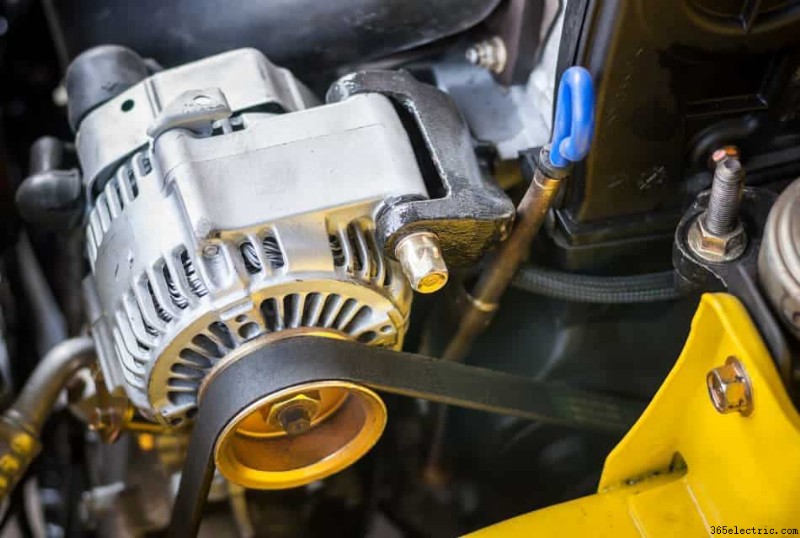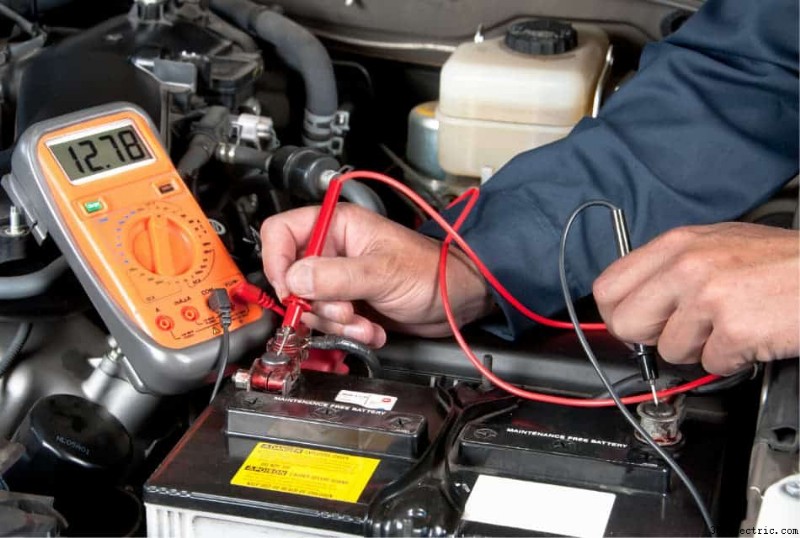Muitas pessoas reclamam que depois de instalar o áudio do carro, o subwoofer acabou com a bateria do carro, mas esse problema é realmente causado por um subwoofer?
Fiz algumas pesquisas para descobrir se um amplificador de carro pode drenar sua bateria, e os resultados são bastante interessantes.
Então, um amplificador pode drenar sua bateria?
A resposta simples é sim, mas uma bateria de carro só pode ser descarregada quando envia mais energia do que recebe de volta de um alternador. Em outras palavras, a bateria de um carro se esgota quando não está carregada o suficiente, o que é um problema comum ao usar amplificadores potentes. Além disso, o amplificador drenará a bateria quando estiver conectado diretamente à bateria, sem um fio remoto indo para o estéreo. Nesse caso, o amplificador drenará a bateria do carro, mesmo com o motor desligado. Vamos descobrir o que isso significa e como corrigir esse problema comum.
Por que um carro precisa de bateria?
O papel da bateria em um carro é dar partida no motor e, quando o motor não funciona, a bateria fornece eletricidade para AC, luzes, rádio e outros equipamentos do carro.
Ao contrário do que muitos pensam, uma bateria de carro não produz energia, mas armazena e abastece os equipamentos elétricos do carro com a energia produzida por um alternador. O alternador quando o motor está funcionando fornece ao carro a eletricidade necessária e carrega a bateria ao mesmo tempo.

Você simplesmente não pode ligar o motor sem uma bateria. Você pode, no entanto, tentar empurrar um carro para fazê-lo partir da colina, mas você precisa ter uma transmissão manual para fazê-lo. Coloque uma segunda marcha e, depois de alguns metros, seu carro estará funcionando bem.
Mas vamos voltar ao tópico principal deste artigo e falar sobre baterias.
O que significa quando uma bateria de carro é drenada?
Quando você tenta dar partida em um motor e depois de girar uma chave, não ouve nada ou apenas um som fraco de um motor de partida por um segundo ou menos, provavelmente sua bateria está descarregada. Também pode ser um motor de partida quebrado, mas em 99% dos casos, quando você não pode ligar um motor, o motivo é uma bateria descarregada.
Aconteceu-me muitas vezes, sobretudo nos anos 90, quando conduzia os meus primeiros carros com baterias de segunda mão, correias do alternador soltas, etc.
O motor não pode dar partida porque sua bateria não tem energia suficiente para dar partida e há vários motivos para a bateria ser descarregada:
- Você tem um sistema de áudio poderoso com um alternador padrão ou o próprio alternador está danificado
- O equipamento do carro consome muita energia quando o motor não está funcionando. Por exemplo, quando você deixou as luzes durante a noite ou ouviu música por muito tempo
- O nível de água na bateria está muito baixo ou os terminais da bateria estão manchados
O sistema de áudio do meu carro é muito potente para minha bateria?
É uma dúvida comum quando, após a instalação de um amplificador potente, começam a aparecer problemas com baterias. As capacidades das baterias montadas na fábrica são projetadas para caber em um carro específico com equipamento padrão. Ao adicionar amplificadores adicionais, você aumenta os requisitos do sistema elétrico, dependendo da
potência do amplificador. Para calcular a amperagem exata do seu amplificador, você deve dividir o RMS total do seu amplificador (não por canal), por 13,8V. A tabela abaixo mostra a amperagem para os amplificadores do carro. Eu usei para este exemplo eficiência de 70%:
| Amplifier RMS (Watt) | Amperagem necessária se o amplificador for 100% eficiente | Amperagem real necessária (com 70% de eficiência) |
|---|
| 100 | 7 | 10 |
| 200 | 14 | 21 |
| 400 | 29 | 41 |
| 600 | 43 | 62 |
| 800 | 58 | 83 |
| 1200 | 87 | 124 |
| 1600 | 116 | 166 |
| 2000 | 145 | 207 |
| 2400 | 174 | 248 |
| 2800 | 203 | 290 |
| 3200 | 232 | 331 |
| 3600 | 261 | 373 |
| 4000 | 290 | 414 |
The table shows how high amperage has to be supported by car alternators, in addition to the standard car equipment.
If your total amperage demand in a car exceeds what your alternator is capable of producing, even the most durable battery will be dead because it always has to support an alternator. In effect, it will never be charged unless you will turn a radio on, and power demand will drop.
When looking at the battery label, you will see two important symbols with numbers behind them. It is worth remembering what they mean.
- Ah – Ampere Hours , that means for how many hours, your battery can supply your car with 12V power. For example, battery Ah65 can continuously provide 1amp for 65 hours or 10amps for 6.5 hours until is fully discharged.
- CCA – Cold Cranking Amps mean how many amps your battery can deliver consistently for 30 seconds in temperature 0°F until voltage will drop below 7.2V.
The table below shows popular conversions between CCA and Ah and how powerful amplifiers you can connect to your battery without further modifications. Assuming that 40% of the battery amperage powers car equipment, and the remaining 60% you can use for car audio amplifier.
| Battery CCA | Battery Ah | Max amplifier RMS |
|---|
| 410 | 45 | 246 |
| 550 | 100 | 546 |
| 650 | 100 | 546 |
| 680 | 100 | 645 |
| 710 | 120 | 655 |
| 730 | 115 | 628 |
| 740 | 115 | 628 |
| 750 | 120 | 655 |
| 760 | 120 | 655 |
| 850 | 140 | 764 |
| 900 | 160 | 874 |
| 950 | 190 | 1037 |
From the above, you see how powerful amplifier you can install in your car, without facing any later issues with the battery being drained.
For example, when you have a car battery CCA710, you will be OK with a 650W amp, but for a 900W amplifier, this battery is a no-go.
If you listen to the music nonstop while driving, the battery will never be charged by the serial alternator, and it is a matter of time before it will eventually die. Strong amplifiers do not only cause drained batteries but also you may notice dimming headlights or flickering dash lights. Also, it can happen that the amp will not receive full power, so your bass will be weak.
How to Keep an Amplifier from Draining Battery?

When you have a powerful amplifier, or more than one, and to make sure that your battery will never drain because of the car audio, you have to consider replacing an alternator with the powerful one. This way, you will be able to supply enough energy for your car’s audio system, and at the same time, your battery will always be charged.
A few months ago, I replaced in my wife’s car standard amplifier with Mechman 370A, and it works great. I have had no problem with batteries since then, and she is using a quite powerful Rockville RXH-F5 with 1600W RMS. (link to Amazon opens in the new window)
The new alternator cost me over $500, and yes, it is expensive but when I put this price against risking often battery replacement, and time for a regular charging battery at home, it balances out.
Typical alternators mounted in an average passenger car can produce between 80 – 120A depending on the model. This 80A will support around 660W RMS from the amplifier, and if you do not have more power, you do not need a stronger alternator.
But what will happen when you add a 2000W amplifier to your car for a subwoofer? This is an additional over 100A, which a standard amplifier simply cannot produce. Many people went through this many times, and the effect was always the same.
A brand new battery was installed, and with a standard alternator after a few weeks or months, the battery was gone, and the process of regular daily recharging at home begins. This is not the way I want to go, I want to have in a car enough power to support my car audio.
When you listen to music mainly when the engine is on, adding a powerful alternator is the only solution to keep your battery in good condition and the whole system without energy shortage.
Before you start making electrical changes in your car, you need to know if this is really necessary, especially when your amplifier is not the most powerful, so its power consumption should be supported by standard car equipment. The best way to find out is to test both a battery and an alternator.
How to Test Battery And Alternator?

Testing the battery voltage and alternator charging quality is the best way to find out how healthy both are.
To perform the test, you need a voltmeter and no more than 5 minutes of your time, you will also need someone to start your engine while you make a test and the whole test can be done at home. I am using
Crenova MS8233D digital meter and I am happy with it.
Before the test, make sure both battery terminals are clean and without corrosion. If you notice corrosion on the terminals, you need to clean them.
Take the leads off and clean using sandpaper, then when clean, put them back together. I use it for cleaning
sandpaper grids 100 or 120 , and it works well. After that, spray both with a
WD40 . This will prevent terminals from getting rusty.
Check alternator wires for any corrosion, if they sit well in the pockets. Also, check if the alternator belt is tight, and if it is not, this will cause a problem while charging a battery.
- Turn headlights on and run it for around 2 minutes
- Do not turn a radio on, or anything else in a car
- Set the voltmeter to value over 12V DC. Depending on the model, it can be 16 or 20V.
- Connect a red voltmeter wire with the positive battery terminal
- Connect a black voltmeter wire with the negative battery terminal (ground)
- Read the value on the voltmeter, for the good battery, you should see over 12.4V, in most cases closer to 13V.
- Do not unplug the voltmeter and start the engine, during start value on the voltmeter should drop to around 10V, and then jump right back to over 13V.
Test Results
When you start an engine and voltage drops below 10V, that means your battery is weak. And if drops below 6V, your battery is dead and needs to be replaced. If your engine works and you see voltage always between 13.2V and 14.7V, that means the alternator is in good condition and is charging the battery. In this case, you have nothing to worry about, both parts are working great.
- The next step is to turn your electrical equipment on, lights, AC, fan, radio, The value on the voltmeter should drop to over 13V. If you see over 13V with your car audio on, your alternator and battery are in excellent condition.
But, if you see a voltage below 12.7V, that means an alternator does not produce enough power for the demanding equipment in your car and does not charge a battery at the same time. In this case, an alternator should be replaced. Related Questions
Do I Need a Capacitor For My Car Audio?
Adding a capacitor helps to stabilize voltage in a car. This is especially important for powerful car audio systems, where together with
loud bass , you notice dimming headlights. An amplifier and battery cannot handle such a spike in energy demand, so an external capacitor is needed.
In
this article , you will find more information about car audio capacitors, which ones to use, and how to connect them.
Do I Need an Extra Battery For Car Audio?
Adding a second car battery works only when you listen to the music with the engine turned off.
Extra battery , depending on the amplifier’s power consumption, can extend the listening time from a few minutes to another hour.
When the additional battery is connected in parallel between an original one and amplifier, the whole system works exactly like a standard battery but with extra capacity. To know more about additional batteries for car audio
read this article .


